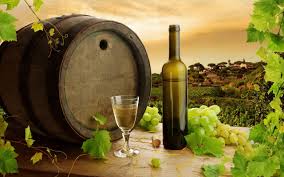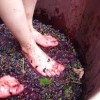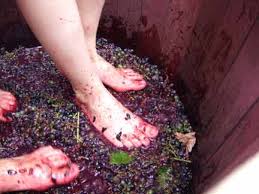Posted on 25 June 2014. Tags: banner ads, banner advertising, banner link advertising, fruit, grape crusher, grapes, text ads, text advertising, text link advertising, wine, wine making
As you contemplate the prospect of making your next batch of wine you will need to decide whether you want to use fruit, such as grapes, or packaged fruit juices. Packaged juices are known as concentrates and can be easily purchased online as well as in home brewing stores. There are many advantages to using concentrates, including the fact that they come with easy to follow directions and usually all of the extra ingredients you may need. Many novice winemakers feel that concentrates are a great introduction to the process of winemaking. There are also advantages to using fruit rather than concentrates; however. The main advantage to using fruit is that you have more control over the process, and thus the results, when you use fruits.
For the most part, the process of making wine from fruit is similar to making it using concentrates. There are a few differences; however, and those differences are critical.
Before you begin, you will need to make sure that you have plenty of fruit. It is not uncommon for many novice winemakers to think they have a sufficient amount of fruit when in fact they do not. You will need at least 70 pounds of grapes in order to produce six gallons of wine. This is the equivalent of about two bushels. The one exception to this is if you are using wild grapes such as Muscadine. In that case you will only need about 25 pounds of grapes due to the fact that wild grapes tend to have a stronger flavor as well as more acid.
Since you will be dealing with a large amount of grapes, you will need to make sure that you have sufficient facilities to deal with them properly. Before you are able to use them to make wine, you will need to remove the stems as well as crush the grapes. Later, the grapes will then need to be pressed after they have had a few days to ferment.
You can easily remove the stems as well as crush the grapes by hand. For small batches of grapes, you can use something as simple as a potato masher to crush the grapes; just make sure it has been cleaned and sanitized first. If you are dealing with larger amounts of grapes it may be worth it to go ahead and invest in a grape crusher as this will speed the process along.
As previously mentioned, after the grapes have fermented for a few days, you will need to press the pulp in order to extract as much juice as possible. In the event you are making white wine, the grapes will need to be pressed directly after they have been crushed but before the first fermentation.
When working with fruit rather than concentrate you will also need to have a hydrometer on hand in order to assist you in controlling the sugar level. As you may recall, this essential in determining the alcohol level in the final wine so it is a step that must not be overlooked.
An acid test kit may also be helpful in controlling and monitoring the levels of acid that are present in your wine when you are using fruit rather than concentrate. When the acid level in the wine is too high, the resulting wine will typically have a taste that is too sour or sharp. If there is not enough acid; however, the wine may taste somewhat flat. An acid test kit will provide you with accurate readings and help you to determine whether you need to add water or acid blend for balance.
Posted in Wine 101, Winemaking

Posted on 01 June 2014. Tags: basic steps of wine making, blending, bottling, crush grapes, fermentation, grape concentrate, grapes, harvest grapes, home brewing stores, remove stems, sulfites, wine, wine connoisseur, wine kit, wine making, wine making steps, yeast

If you are a true wine connoisseur, the next step in appreciating a fine wine may be to make your own wine at home. While the process may seem to be complicated, wine can be made rather easily at home. Before beginning the process of making your own wine at home it is important to understand the basic steps of wine making.
In order to make wine at home you will need either grape concentrate or grapes. If you have a sufficient growing area, you may choose to grow your own grapes and make wine from that. If you choose to use grape concentrate, keep in mind that you will need to use high quality grape concentrate. This can be purchased online as well as in wine and home brewing stores. In addition, you will need yeast and brewing equipment. If this is your first batch of wine you may wish to consider purchasing a wine kit rather than buying all of your equipment separately. After you have had a chance to experiment with making wine at home and decided whether it is an endeavor you wish to continue you might then begin accumulating various pieces of equipment for brewing larger batches of wine.
Five to Eight Basic Steps
There are five to eight basic steps involved in the process of making wine, depending on whether you are using grapes or concentrate.
(1) If you are using grapes then the fruit will obviously need to be harvested first.
(2) After the grapes have been harvested, you will then need to remove the stems from the grapes. This is an absolutely essential step as very bitter tannins are contained in the stems that can have a heavy influence on the wine.
(3) After the stems have been removed, the skins of the grapes will then need to be broken in order to release the juice from the fruit. There are certainly many different ways in which to do this. Crushing is the preferred method for most winemakers. The degree to which the fruit is crushed will have an impact on the resulting wine. If your goal is to create a wine that has a fruity aroma then you may wish to leave the berries almost completely intact.
(4) The next step is known as the primary fermentation. During this step the yeast cells contained in the wine will feed on the sugars. Alcohol and carbon dioxide is produced as a result. In some cases, you may wish to add additional yeast. This helps to ensure a stable and consistent conversion which may not be the case if you rely solely on the yeast that is found on the fruit itself.
(5) After the primary fermentation, more juice will need to be extracted from the fruit. It should be noted that the juice that is extracted in this step is typically not as high of a quality as the juice that is extracted during the crushing phase. This is because the juice that is obtained during crushing, known as free run juice, has had less contact with the stems and skins. This does not mean that press juice is useless; however. Even large wineries may choose to use press juice in order to increase their yield.
(6) A secondary fermentation occurs after the pressing, at the same time as the wine is aging. As the winemaker, it will be up to you to determine how long the wine should ferment.
(7) Blending is an optional part of the process; however, one which can assist you in creating a highly customized wine. Blending is most commonly used in order to improve two or more batches which may be slightly lacking.
(8) The last step of the process is bottling. The wine is poured into bottles and at times you may wish to add sulfites in order to help end fermentation as well as to preserve the wine. Finally, the bottle of wine is sealed with a cork.
Making wine at home can be a very enjoyable experience. As you learn more about the process of making wine, you will likely gain a more thorough appreciation of wine.
Posted in Winemaking

Posted on 26 May 2014. Tags: fermentation, filter, grape concentrate, grapes, home wine making, wine, wine making, winemaking

Real Grapes or Grape Concentrate
One of the great advantages of making your own wine is that you are able to take control of as much of the process as you want. If you want to grow and harvest your own grapes or any other kind of fruit and produce wine you can control every aspect of the process. If, on the other hand, you choose to purchase grape concentrate, you can begin making your wine from that point on. Making wine is largely about making a number of different decisions and taking various factors into consideration. Each factor and each decision will have an impact on your final wine.
Grape Clusters or De-Stem
One of the first choices you will need to make if you elect to make grape wine and use fruit in order to do it instead of concentrate is whether you want to de-stem the grapes or use the entire cluster. When making this decision it is important to keep in mind that it really does make a difference. If you decide to use the whole cluster then you will find that your wine has a certain flavor and even nuance that is not present if you de-stem the grapes first. This flavor may or may not be appealing to you. Some people describe it as somewhat ‘green.’ If you like that sort of flavor, then using a whole cluster is an excellent choice. A number of very good, award winning wines are produced using the entire cluster. If; however, you do not think you would like that flavor, then it is best to go ahead and de-stem the grapes before you use them for your wine.
Barrel or Tank Fermentation
Another choice you will have to make is how you want to ferment the must. Yes, there are choices to make here as well. You have two basic choices. You can either ferment in a barrel or a tank. Most winemakers prefer to ferment using a tank. This gives you greater control over the process because the sleeves on the tank give you the option to either heat or cool the must. For example, in the beginning of the fermentation process you may wish to ensure the tanks are cool in order to extract the color from the grape skins. This can also help to stabilize the wine. Of course, you can also choose to ferment your wine in a barrel. This is a popular method when producing white wines because it tends to give them some character that might not be possible from tank fermentation. In the end, it is really up to you and your personal choice, but you will need to make this decision before you produce your first batch of wine.
Yeast Choices
You will also need to give some thought to the types of yeast that you wish to use. Most beginning winemakers are not aware of the fact that grapes picked straight from the vineyard actually have yeast on them. These are naturally occurring yeasts. As a result, you may choose not to add any additional yeast to the fermentation mix. In this case, you can allow the natural or native yeasts to work on their own. The one downside to this problem is that you may run into a problem known as a stuck fermentation. This is when the yeast reaches a certain point and then it just simply stops. Generally, yeasts that are created in the lab will be more stable. Of course, there is a downside to this as well. Many winemakers feel that lab created yeasts are lacking in flavor when compared to natural yeasts.
If you do choose to use natural yeasts, you will need to be prepared to handle a stuck fermentation in the event that it does occur. Adding a yeast nutrient or energizer can often help to combat this problem by providing the natural yeasts the ‘kick’ they need to finish the fermentation process.
Filter or Not to Filter
Finally, you will need to give some thought to whether you wish to filter or not filter your wine. There is no set rule regarding this matter. You may find that a wine that has been unfiltered will have a great amount of richness; however, do be aware that there are bacterial issues which may arise if you choose not to filter your wine. In addition, wines that have not been filtered tend to have a cloudier appearance than those that have been filtered.
Posted in Winemaking

Posted on 25 January 2014. Tags: equipment, wine kits, wine making, winemaking

Making wine from home can sometimes be a costly process to start and it may take quite a bit of your time and effort to make a decent batch. Understanding the proper procedure and what to expect along the way can help you start the process off correctly and save you a lot of trial and error.
Equipment
Get everything you’re going to need before you begin to avoid having to halt your wine making process and search for an additional piece of equipment you may have forgotten. To begin the process you’ll need a fermenting vat to ferment your grapes in. You’ll need to have bottles, corks, and labels ready once your wine is complete in order to prepare it for storage.
Depending on the process you’ll be using you may need oak casks for aging, glass jugs, a hydrometer, a fermentation lock, crushing gates, and an acid titration kit. Wine kits can be purchased that will provide everything you’ll need including chemicals and additional supplies. Some companies will even provide instructions or lessons on the wine making process if you need it.
Ingredients
The main thing you’re going to need for making wine is the grapes or any other fruits you plan on using. It takes about 70 pounds of grapes to make 6 gallons of wine, and you’ll want to make sure you know what type of wine you can make out of the grape varietal you chose. Fruit concentrates can also be used which may be easier than crushing your own grapes, but you may have less control over the end product with this option. If you have the proper space and live in an appropriate region, you may choose to even grow your own grapes.
Sugar, yeast, and additional chemicals will also be required for the process. You’ll need Campden tablets, which are a sulphur-based brewing product, to add to your wine while it is being made. These tablets kill certain bacteria and prevent the growth of wild yeast.
Procedure
The grapes are crushed to form a must for red wines, or the juice is extracted from t he skins and seeds to use for whites. The must or grape juice is fermented in a vat for usually around a week or two then racked to remove sediment. The racking process may be repeated a multiple times depending on the amount of sediment left behind or the type of wine you’re making.
Once the wine is siphoned out of the vat and the additional sediment is left behind it can be bottled and will be ready for storage. Knowing how long you’ll be aging the wine you’ve produced will allow you to prepare an appropriate storage area in advance. Some types may be ready for consumption immediately while others may require months or years of aging.
For any new wine makers, errors can be expected regardless of how prepared you are. Once you’ve made a few batches you’ll likely begin to better understand the process and be more confident in your brewing abilities. For anyone with a love of wine this can be a fun and rewarding hobby and for some it can even turn into a lucrative business.
Posted in Featured Articles, Winemaking








